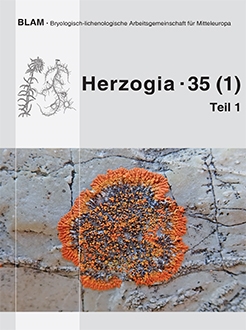Türk, R., Berger, F., Berger, A., Berger, M., Cezanne, R., Dolnik, C., Eichler, M., Gruber, J. P., Grünberg, H., Hafellner, J., Klüssendorf, J., Neumann, P., Otte, V., Schultz, M., Stapper, N., Teuber, D., Thüs, H. & Weber, L. 2022: Flechten und lichenicole Pilze im UNESCO-Biosphärenpark Salzburger Lungau (BLAM-Exkursion 2019) – Herzogia 35: 61–104.
Die im Zuge der BLAM-Exkursion 2019 im Biosphärenpark Lungau aufgefundenen Flechten und lichenicolen Pilze sowie deren Substrate werden in Form einer Liste dargestellt. Die hohe Zahl der Taxa in den neun Exkursionsgebieten – 546 Flechten und 69 lichenicole Pilze – weist auf die große Bedeutung des Lungaus als Rückzugsraum für im übrigen Europa stark gefährdete Arten hin. Als bedeutende Flechtenlokalitäten für amphibische Flechten und Verrucariaceae erwiesen sich die Lonka-Kaskade im Weißpriachtal und die Flächen im Vorfeld des Preberkessels.
Neu für Österreich sind Ephebe perspinulosa, Lempholemma cladodes, Polyblastidium japonicum agg., Pyrenopsis sanguinea, Scytinium biatorinum, Verrucaria cernaensis, V. hunsrueckensis, V. pallidomurina sowie der lichenicole Pilz Crittendenia coppinsii.
Neu für Salzburg sind Absconditella sphagnorum, Absconditella trivialis, Bryobilimbia sanguineoatra, Flavoplaca oasis, Lecanora allophana f. sorediata, Lempholemma dispansum, Lepraria borealis, Placynthium tantaleum, Protothelenella xylina, Ramalina europaea, Scutula dedicata, Scytinium subtile, Spilonema revertens, Staurothele fissa, Trapelia corticola, Usnea wasmuthii, Verrucaria alpicola, V. bryoctona, V. foveolata, V. praetermissa, V. umbrinula und Zahlbrucknerella calcarea sowie die lichenicolen Pilze Arthonia digitatae, Didymocyrtis pseudeverniae, Epicladonia simplex, Epithamnolia rangiferinae, Heterocephalacria bachmannii, Lecanora lecanoricola, Lichenostigma cosmopolites, Muellerella atricola, Neoburgoa freyi, Opegrapha lamyi, Pronectria robergei, Raesaenenia huuskonenii, Sclerococcum parasiticum, Skyttea tephromelarum, Sphaerellothecium leratianum, Stigmidium microcarpum, Tremella cetrariicola, T. cladoniae und T. hypogymniae.
Türk, R., Berger, F., Berger, A., Berger, M., Cezanne, R., Dolnik, C., Eichler, M., Gruber, J. P., Grünberg, H., Hafellner, J., Klüssendorf, J., Neumann, P., Otte, V., Schultz, M., Stapper, N., Teuber, D., Thüs, H. & Weber, L. 2022. Lichens and lichenicolous fungi in the UNESCO biosphere park Salzburger Lungau (BLAM-Excursion 2019) – Herzogia 35: 61–104.
The list of lichens and lichenicolous fungi determined in the course of the 2019 BLAM excursion to the Lungau biosphere reserve is presented with their substrates. The high number of detected taxa in the nine study areas – 546 lichen taxa and 69 lichenicolous fungi – indicates the importance of the Lungau as a refuge for lichen taxa endangered elsewhere in Europe. Significant lichen localities for amphibian lichens and Verrucariaceae include the rapids of the Lonka River in the Weißpriach Valley and the forefield areas of the Preberkessel.
The following species are new to Austria: Ephebe perspinulosa, Lempholemma cladodes, Polyblastidium japonicum agg., Pyrenopsis sanguinea, Scytinium biatorinum, Verrucaria cernaensis, V. hunsrueckensis, V. pallidomurina and the lichenicolous fungus Crittendenia coppinsii.
The following species are new to the province of Salzburg: Absconditella sphagnorum, Absconditella trivialis, Bryobilimbia sanguineoatra, Flavoplaca oasis, Lecanora allophana f. sorediata, Lempholemma dispansum, Lepraria borealis, Placynthium tantaleum, Protothelenella xylina, Ramalina europaea, Scutula dedicata, Scytinium subtile, Spilonema revertens, Staurothele fissa, Trapelia corticola, Usnea wasmuthii, Verrucaria alpicola, V. bryoctona, V. foveolata, V. praetermissa, V. umbrinula and Zahlbrucknerella calcarea and the lichenicolous fungi Arthonia digitatae, Didymocyrtis pseudeverniae, Epicladonia simplex, Epithamnolia rangiferinae, Heterocephalacria bachmannii, Lecanora lecanoricola, Lichenostigma cosmopolites, Muellerella atricola, Neoburgoa freyi, Opegrapha lamyi, Pronectria robergei, Raesaenenia huuskonenii, Sclerococcum parasiticum, Skyttea tephromelarum, Sphaerellothecium leratianum, Stigmidium microcarpum, Tremella cetrariicola, T. cladoniae and T. hypogymniae.





